
Next: 5.3 Eye Movements Up: 5. The Physiology of Previous: Photoreceptor density Contents Index
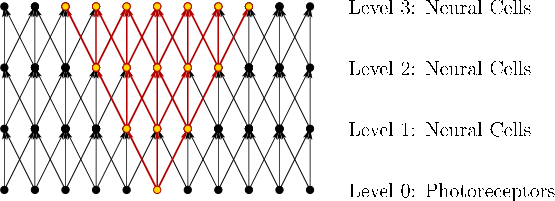 |
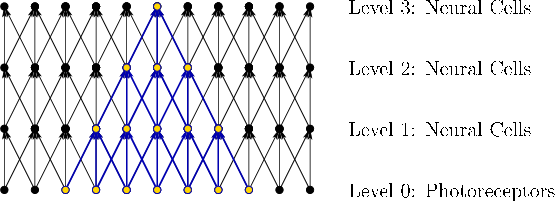 |
Photoreceptors are transducers that convert the light-energy stimulus into an electrical signal called a neural impulse, thereby inserting information about the outside world into our neural structures. Recall from Section 2.3 that signals are propagated upward in a hierarchical manner, from photoreceptors to the visual cortex (Figure 2.19). Think about the influence that each photoreceptor has on the network of neurons. Figure 5.7 shows a simplified model. As the levels increase, the number of influenced neurons grows rapidly. Figure 5.8 shows the same diagram, but highlighted in a different way by showing how the number of photoreceptors that influence a single neuron increases with level. Neurons at the lowest levels are able to make simple comparisons of signals from neighboring photoreceptors. As the levels increase, the neurons may respond to a larger patch of the retinal image. This principle will become clear when seeing more neural structures in this section. Eventually, when signals reach the highest levels (beyond these figures), information from the memory of a lifetime of experiences is fused with the information that propagated up from photoreceptors. As the brain performs significant processing, a perceptual phenomenon results, such as recognizing a face or judging the size of a tree. It takes the brain over ![]() ms to produce a result that enters our consciousness.
ms to produce a result that enters our consciousness.
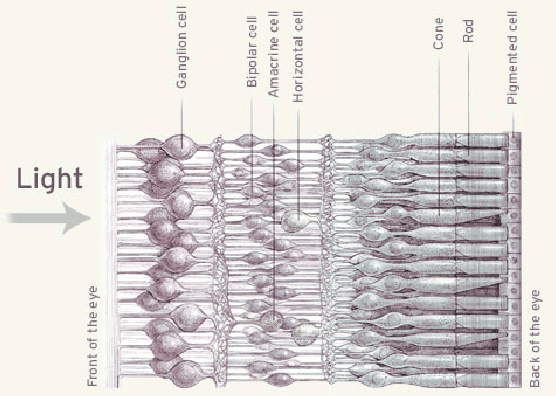 |
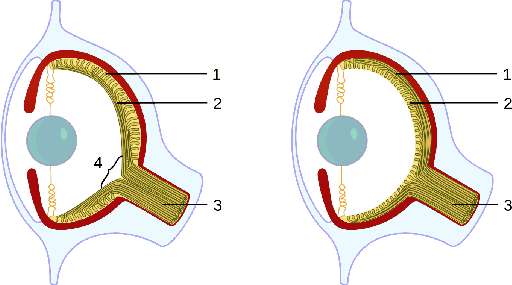 |
Now consider the first layers of neurons in more detail, as shown in Figure 5.9. The information is sent from right to left, passing from the rods and cones to the bipolar, amacrine, and horizontal cells. These three types of cells are in the inner nuclear layer. From there, the signals reach the ganglion cells, which form the ganglion cell layer. Note that the light appears to be entering from the wrong direction: It passes over these neural cells before reaching the photoreceptors. This is due to the fact that the human retina is inside-out, as shown in Figure 5.10. Evolution got it right with octopuses and other cephalopods, for which the light directly reaches the photoreceptors. One consequence of an inside-out retina is that the axons of the ganglion cells cannot be directly connected to the optic nerve (item 3 in Figure 5.10), which sends the signals outside of the eye. Therefore, a hole has been punctured in our retinas so that the ``cables'' from the ganglion cells can be routed outside of the eye (item 4 in Figure 5.10). This causes the blind spot that was illustrated in Figure 5.6.
Upon studying Figure 5.9 closely, it becomes clear that the neural cells are not arranged in the ideal way of Figure 5.8. The bipolar cells transmit signals from the photoreceptors to the ganglion cells. Some bipolars connect only to cones, with the number being between cones 1 and 10 per bipolar. Others connect only to rods, with about 30 to 50 rods per bipolar. There are two types of bipolar cells based on their function. An ON bipolar activates when the rate of photon absorption in its connected photoreceptors increases.
An OFF bipolar activates for decreasing photon absorption. The bipolars connected to cones have both kinds; however, the bipolars for rods have only ON bipolars. The bipolar connections are considered to be vertical because they connect directly from photoreceptors to the ganglion cells This is in contrast to the remaining two cell types in the inner nuclear layer. The horizontal cells are connected by inputs (dendrites) to photoreceptors and bipolar cells within a radius of up to ![]() mm. Their output (axon) is fed into photoreceptors, causing lateral inhibition, which means that the activation of one photoreceptor tends to decrease the activation of its neighbors. Finally, amacrine cells connect horizontally between bipolar cells, other amacrine cells, and vertically to ganglion cells. There are dozens of types, and their function is not well understood. Thus, scientists do not have a complete understanding of human vision, even at the lowest layers. Nevertheless, the well understood parts contribute greatly to our ability to design effective VR systems and predict other human responses to visual stimuli.
mm. Their output (axon) is fed into photoreceptors, causing lateral inhibition, which means that the activation of one photoreceptor tends to decrease the activation of its neighbors. Finally, amacrine cells connect horizontally between bipolar cells, other amacrine cells, and vertically to ganglion cells. There are dozens of types, and their function is not well understood. Thus, scientists do not have a complete understanding of human vision, even at the lowest layers. Nevertheless, the well understood parts contribute greatly to our ability to design effective VR systems and predict other human responses to visual stimuli.
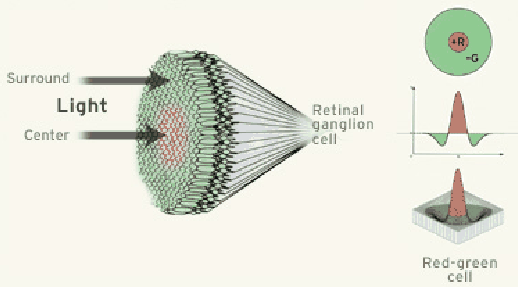 |
At the ganglion cell layer, several kinds of cells process portions of the retinal image. Each ganglion cell has a large receptive field, which corresponds to the photoreceptors that contribute to its activation as shown in Figure 5.8. The three most common and well understood types of ganglion cells are called midget, parasol, and bistratified. They perform simple filtering operations over their receptive fields based on spatial, temporal, and spectral (color) variations in the stimulus across the photoreceptors. Figure 5.11 shows one example. In this case, a ganglion cell is triggered when red is detected in the center but not green in the surrounding area. This condition is an example of spatial opponency, for which neural structures are designed to detect local image variations. Thus, consider ganglion cells as tiny image processing units that can pick out local changes in time, space, and/or color. They can detect and emphasize simple image features such as edges. Once the ganglion axons leave the eye through the optic nerve, a significant amount of image processing has already been performed to aid in visual perception. The raw image based purely on photons hitting the photoreceptor never leaves the eye.
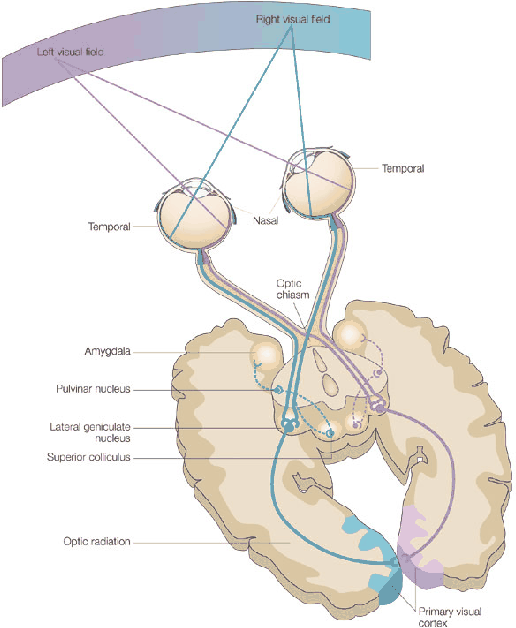 |
The optic nerve connects to a part of the thalamus called the lateral geniculate nucleus (LGN); see Figure 5.12. The LGN mainly serves as a router that sends signals from the senses to the brain, but also performs some processing. The LGN sends image information to the primary visual cortex (V1), which is located at the back of the brain. The visual cortex, highlighted in Figure 5.13, contains several interconnected areas that each perform specialized functions. Figure 5.14 shows one well-studied operation performed by the visual cortex. Chapter 6 will describe visual perception, which is the conscious result of processing in the visual cortex, based on neural circuitry, stimulation of the retinas, information from other senses, and expectations based on prior experiences. Characterizing how all of these processes function and integrate together remains an active field of research.
Steven M LaValle 2020-11-11